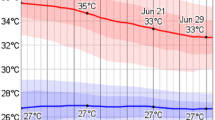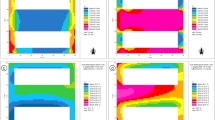Abstract
The main objective of this paper was to establish the effect of anthropogenic heat flux on the formation of mixing depth specially in urban areas. In this study an energy balance mixing depth model was developed for the simulation of mixing depth incorporating the heat island effect. To demonstrate the effect of heat island, mixing depths were simulated under two conditions. Under the first condition, hourly gridded anthropogenic heat flux and variant surface characteristics were considered, while under the second condition anthropogenic heat flux term was ignored and constant surface characteristics were considered throughout the modelling domain. The release of anthropogenic heat flux in the urban environment was found to be responsible for the growth of the unstable layer in the lower atmosphere even during the night. This resulted in higher mixing depth values in urban areas compared to the surrounding countryside. The maximum differential surfaces sensible heat flux between urban and rural areas was estimated as 130 W/m2. From the simulation of mixing depth, it was revealed that the maximum increment in mixing depth in urban areas was 300 m due to the heat island effect. This increment in mixing depth in urban areas can provide an extra space for dilution and mixing of pollutants.
Similar content being viewed by others
References
S.P.S. Arya, Parameterising the height of the stable atmospheric boundary layer, J. Applied Meteorology 20 (1981) 1192–1202.
T. Asaeda and V.T. Ca, Heat storage of pavement and its effect on the lower atmosphere, Atmospheric Environment 30 (1996) 413–427.
D.J Carson, The development of a dry inversion-capped convectively unstable boundary layer, Quart. J. Royal Meteorological Society 99 (1973) 450–467.
Commonwealth Department of Primary Industries and Energy, Australian Petroleum Statistics, December 1996 (1996).
S.R. Hanna, J.C. Weil and R.J. Paine, Plume model development and evaluation, Report Number D034-500, Electric Power Research Institute, Palo Alto, CA (1986).
A.M. Holtslag and A.P. Van Ulden, A simple scheme for daytime estimates of the surface fluxes from routine weather data, J. Climate Applied Meteorology 22 (1983) 517–529.
S.M. Khan and R.W. Simpson, Modelling mixing height from routinely measured surface and upper air meteorological data, Environmental Modelling and Assessment 2 (1997) 191–200.
K. Klysik, Spatial and seasonal distribution of anthropogenic heat emissions in Lodz, Poland, Atmospheric Environment 30 (1996) 3397–3404.
D.M. Leahey and J.P. Friend, A model for predicting the depth of the mixing layer over an urban heat island with applications to New York city, J. Applied Meteorology 10 (1971) 1162–73.
P.R. Maul, Atmospheric transport of sulfur compound pollutants, Central Electricity Generating Bureau MID/SSD/80/0026/R, Nottingham, England (1980).
T.R. Oke, The energetic basis of the urban heat island, Quarterly J. Royal Meteorological Society 108 (1982) 1–24.
R.A. Pielke, Mesoscale Meteorological Modelling (Academic Press Inc., 1984).
J.S. Scire, F.W. Lurmann, A. Bass and S.R. Hanna, User's guide to the MESOPUFF II model and related processor programs, EPA-600/8-84-013, U.S. Environmental Protection Agency, Research Triangle Park, NC (1984).
R.D. Small, Environmental impact of fires in Kuwait, Nature 350 (1991) 11–12.
D.G. Steyn and T.R. Oke, The depth of the daytime mixed layer at two coastal locations: A model and its validation, Boundary Layer Meteorology 24 (1982) 161–180.
R.B. Stull, An Introduction to Boundary Layer Meteorology (Kluwer Academic Publishers, Dordrecht, The Netherlands, 1994).
K.E. Torrance and J.S.W. Shun, Time varying energy consumption as a factor in urban climate, Atmospheric Environment 10 (1976) 329–337.
USEPA, A User's Guide for the CALMET Meteorological Model, EPA-454/B-95-002, Emissions, Monitoring and Analysis Division (MD-14), Research Triangle Park, NC 27711 (1995).
A. Venkatram, Estimating the Monin–Obukhov length in the stable boundary layer for dispersion calculations, Boundary Layer Meteorology 19 (1980) 481–485.
A. Venkatram, Estimation of turbulence velocity scales in the stable and the unstable boundary layer for dispersion applications, in: Eleventh NATO-CCMS International Technical Meeting on Air Pollution Modeling and its Application (1980) pp. 54–56.
J.C. Weil and R.P. Brower, Estimating convective boundary layer parameters for diffusion applications, Report PPSP-MP-48, Prepared by Environmental Centre, Martin Marietta Corporation forMaryland Department of Natural Resources, Armapolis, MD (1983).
N. Wheeler, Modeling of mixing depths during a southern California air quality study ozone episode, Proceedings of the AWMA International Specialty Conference on Tropospheric Ozone and the Environment, March 19–22, Los Angeles, CA (1990).




